

Compact Muon Solenoid
LHC, CERN
| CMS-PAS-EXO-18-013 | ||
| Search for excited leptons decaying via contact interaction to two leptons and two jets | ||
| CMS Collaboration | ||
| March 2019 | ||
| Abstract: A search is presented for excited electrons and excited muons decaying via a contact interaction to final states of two leptons and two jets. This channel complements other searches for excited leptons with radiative or neutral current decays. In all cases, excited leptons would be produced via contact interaction with a characteristic energy scale Λ. The branching fraction of this decay channel increases with excited lepton mass and thus is expected to be the most sensitive search channel for very heavy excited leptons. The analysis uses proton-proton collision data collected in 2016 and 2017 with the CMS detector at the LHC at a center-of-mass energy of 13 TeV, corresponding to an integrated total luminosity of 77.4 fb−1. The four-body invariant mass distribution is used as the discriminating variable for this search and no significant deviation from the standard model prediction is found. Exclusion limits are set at the 95% confidence level. For the case where the characteristic scale is equal to the excited lepton mass, excited electrons and muons below 5.6 TeV and 5.7 TeV, respectively, are excluded. These are the most stringent exclusion limits to date on the excited lepton mass. | ||
|
Links:
CDS record (PDF) ;
CADI line (restricted) ;
These preliminary results are superseded in this paper, JHEP 05 (2020) 052. The superseded preliminary plots can be found here. |
||
| Figures | |
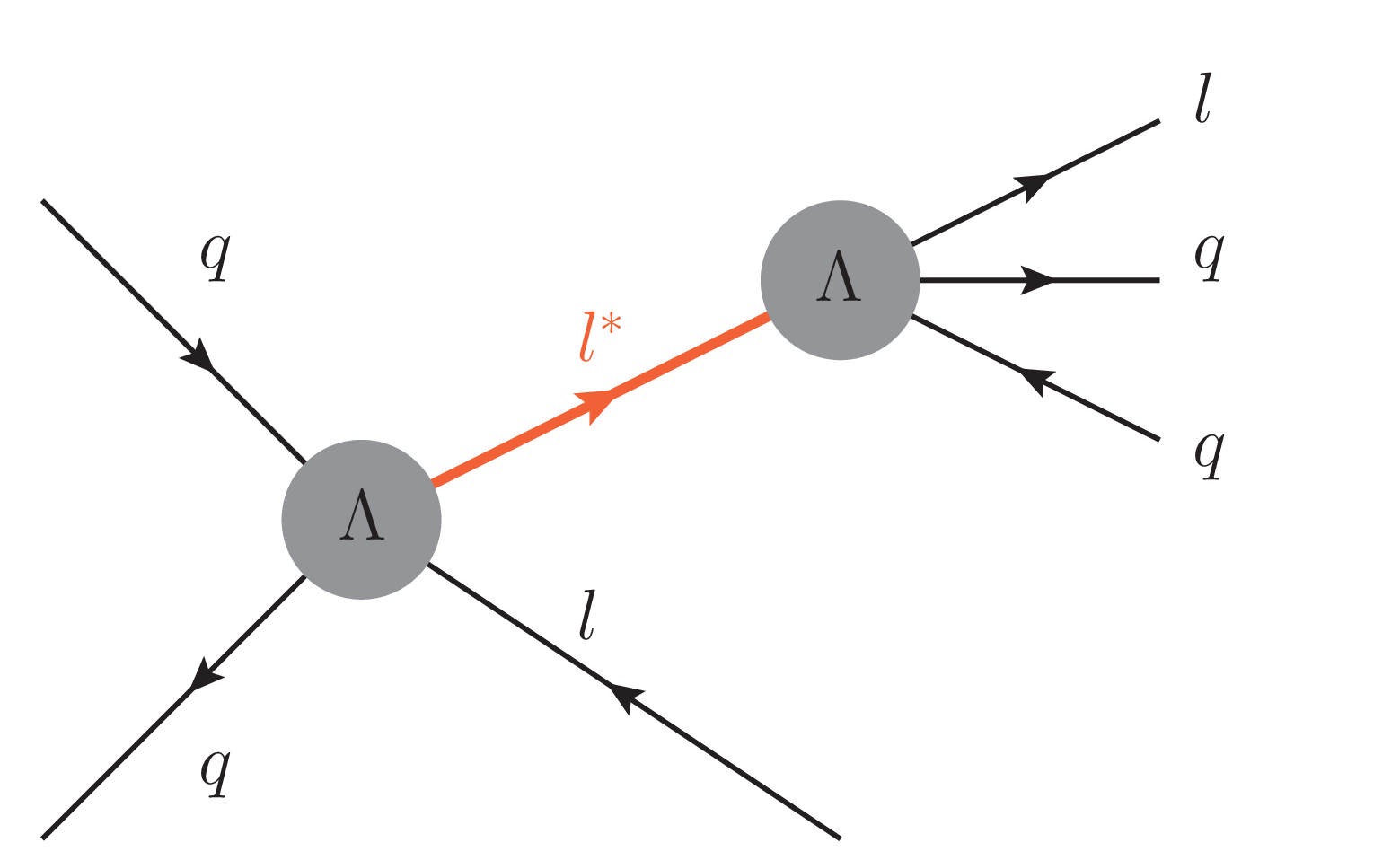
png pdf |
Figure 1:
Feynman diagram for the production of an excited lepton in association with a SM lepton in a hadron collider. It subsequently decays via a CI to one SM lepton and two resolved jets. |
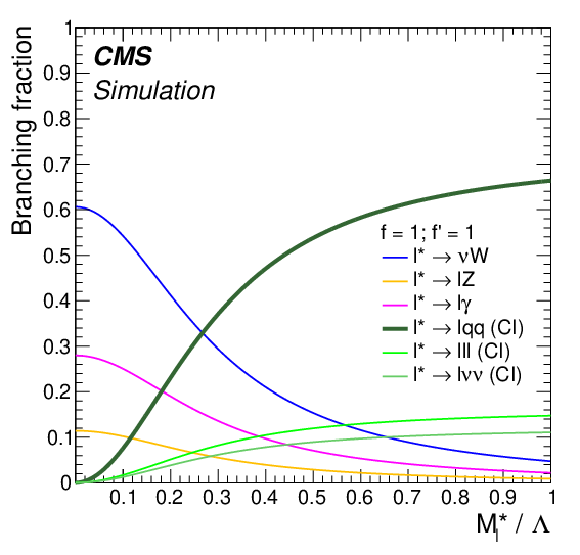
png pdf |
Figure 2:
Branching fraction of excited lepton decay channels as a function of the ratio of excited lepton mass (Mℓ∗) and compositeness scale (Λ) for fixed values of the model parameters f=f′= 1, which represent the coupling of excited leptons to SM particles, as described in Sec. 3. |
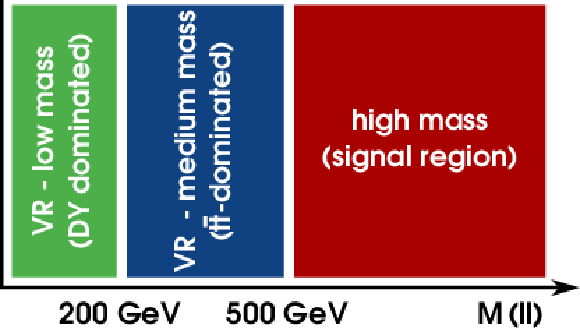
png pdf |
Figure 3:
Definition of the two validation regions (VR) and the high-mass signal region. |
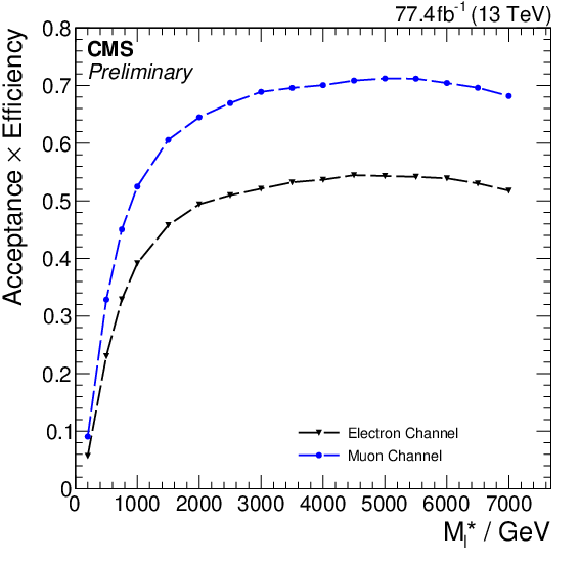
png pdf |
Figure 4:
Signal selection efficiency after all selection steps. |
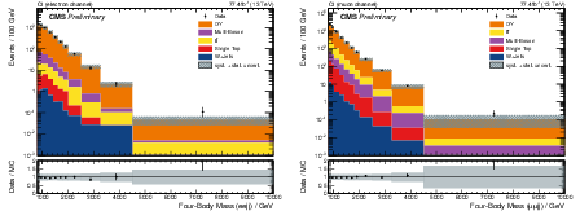
png pdf |
Figure 5:
The distribution of the four-body invariant mass is shown for the electron (left) and muon (right) channels, for the low-mass validation region defined by Mℓℓ< 200 GeV. The lower panel shows the ratio of data to the simulated SM background with the shaded band representing the uncertainty. |
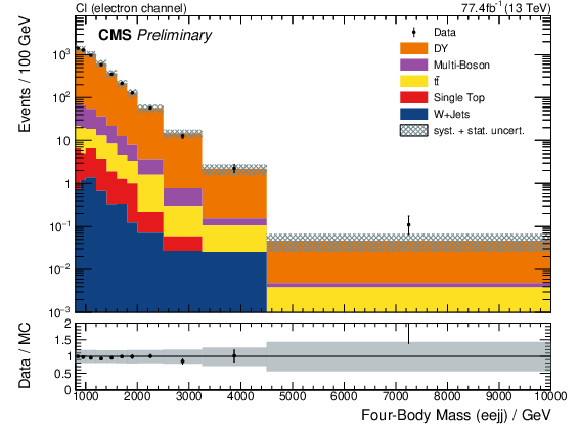
png pdf |
Figure 5-a:
The distribution of the four-body invariant mass is shown for the electron channel, for the low-mass validation region defined by Mℓℓ< 200 GeV. The lower panel shows the ratio of data to the simulated SM background with the shaded band representing the uncertainty. |

png pdf |
Figure 5-b:
The distribution of the four-body invariant mass is shown for the muon channel, for the low-mass validation region defined by Mℓℓ< 200 GeV. The lower panel shows the ratio of data to the simulated SM background with the shaded band representing the uncertainty. |
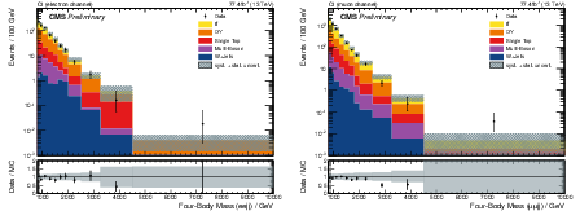
png pdf |
Figure 6:
The distribution of the four-body invariant mass is shown for the electron (left) and muon (right) channels, for the medium-mass validation region defined by 200 <Mℓℓ< 500 GeV. The lower panel shows the ratio of data to the simulated SM background with the shaded band representing the uncertainty. |

png pdf |
Figure 6-a:
The distribution of the four-body invariant mass is shown for the electron channel, for the medium-mass validation region defined by 200 <Mℓℓ< 500 GeV. The lower panel shows the ratio of data to the simulated SM background with the shaded band representing the uncertainty. |
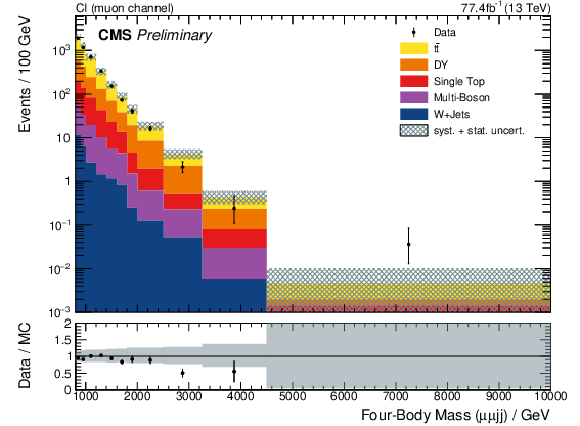
png pdf |
Figure 6-b:
The distribution of the four-body invariant mass is shown for the muon channel, for the medium-mass validation region defined by 200 <Mℓℓ< 500 GeV. The lower panel shows the ratio of data to the simulated SM background with the shaded band representing the uncertainty. |
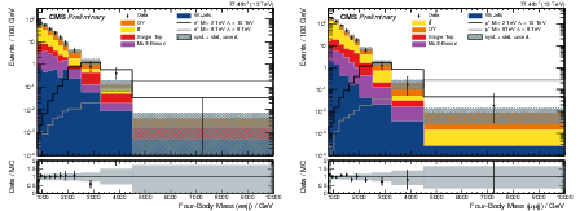
png pdf |
Figure 7:
Distribution of the two lepton two jet invariant mass in the signal region (Mℓℓ> 500 GeV) for the electron (left) and muon (right) channels. The data correspond to 77.4 fb−1 recorded during 2016 and 2017. The example signal shape for two excited lepton masses is indicated as a grey line with the parameters given in the legend. The panel below shows the data/MC ratio with the total uncertainty in grey. |
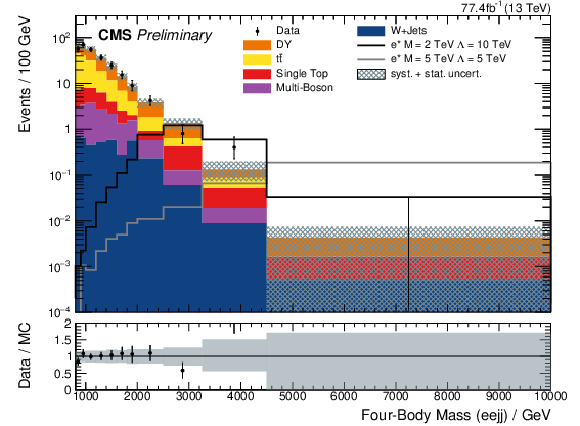
png pdf |
Figure 7-a:
Distribution of the two lepton two jet invariant mass in the signal region (Mℓℓ> 500 GeV) for the electron channel. The data correspond to 77.4 fb−1 recorded during 2016 and 2017. The example signal shape for two excited lepton masses is indicated as a grey line with the parameters given in the legend. The panel below shows the data/MC ratio with the total uncertainty in grey. |

png pdf |
Figure 7-b:
Distribution of the two lepton two jet invariant mass in the signal region (Mℓℓ> 500 GeV) for the muon channel. The data correspond to 77.4 fb−1 recorded during 2016 and 2017. The example signal shape for two excited lepton masses is indicated as a grey line with the parameters given in the legend. The panel below shows the data/MC ratio with the total uncertainty in grey. |
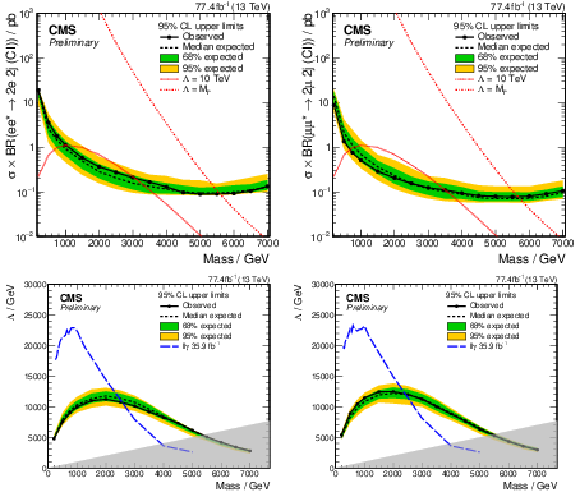
png pdf |
Figure 8:
Cross section limits on excited leptons using the Mℓℓjj distribution for the electron (left) and muon (right) channels. The expectation from the model is represented by two cases, Λ=Mℓ∗ and Λ= 10 TeV for which the signal events are simulated. The cross section scales with Λ. |
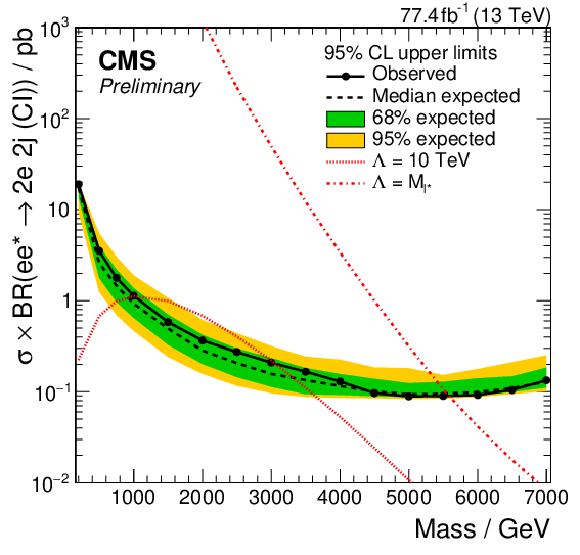
png pdf |
Figure 8-a:
Cross section limits on excited leptons using the Mℓℓjj distribution for the electron channel. The expectation from the model is represented by two cases, Λ=Mℓ∗ and Λ= 10 TeV for which the signal events are simulated. The cross section scales with Λ. |

png pdf |
Figure 8-b:
Cross section limits on excited leptons using the Mℓℓjj distribution for the muon channel. The expectation from the model is represented by two cases, Λ=Mℓ∗ and Λ= 10 TeV for which the signal events are simulated. The cross section scales with Λ. |
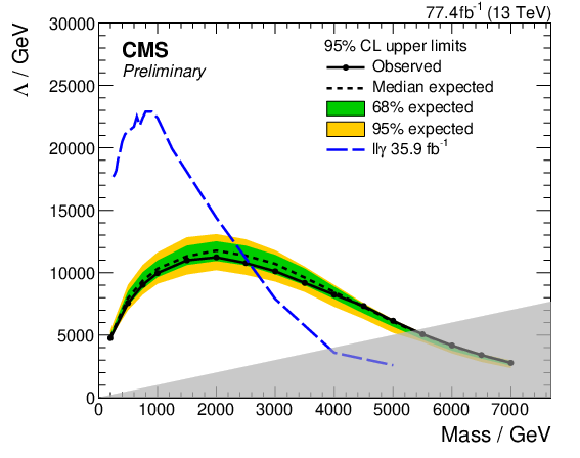
png pdf |
Figure 9-a:
Limits on the compositeness scale Λ for the electron channel. In addition, the Λ limits from a recent CMS search in the ℓℓγ channel [23] are shown as a blue, dashed line. The latter addresses only the scenario of f=f′ while the hadronic CI channel is sensitive to this and the scenario f=−f′. The model is not valid in the hatched area. |

png pdf |
Figure 9-b:
Limits on the compositeness scale Λ for the muon channel. In addition, the Λ limits from a recent CMS search in the ℓℓγ channel [23] are shown as a blue, dashed line. The latter addresses only the scenario of f=f′ while the hadronic CI channel is sensitive to this and the scenario f=−f′. The model is not valid in the hatched area. |
| Tables | |

png pdf |
Table 1:
Observed event yields for 77.4 fb−1 compared to the expected SM background for the 2e2j and 2μ2j final state, respectively. Also shown are the expected event numbers for two signal examples with the given parameters. The events are given in bins of the discriminating four-body mass (2ℓ2j) distribution, with lower and upper value for each bin given in units of GeV. Uncertainties are systematic as described in the text. |

png pdf |
Table 2:
Summary of the observed (expected) limits on ℓ∗ mass, assuming Mℓ∗=Λ, for the cases f=f′ and f=−f′. The latter case is not applicable to ℓℓγ. |
| Summary |
|
A search for excited leptons decaying via contact interaction to final states of two electrons or two muons and two resolved jets was carried out. This channel complements other searches for excited leptons. It has greatest sensitivity at large values of Mℓ∗ and/or Λ and is therefore most sensitive to very heavy excited leptons. The utilized data for this analysis were recorded with the CMS detector in the years 2016 (35.9 fb−1) and 2017 (41.5 fb−1), corresponding to a total integrated luminosity of 77.4 fb−1 of proton-proton collisions at a center-of-mass energy of 13 TeV. No significant deviations were observed in the signal region and 95% exclusion limits are set. Excited electrons (muons) up to masses of Me∗= 5.6 TeV (Mμ∗= 5.7 TeV) are excluded with the usual assumption of Mℓ∗=Λ. These are the best limits to date. The limit was also re-evaluated in terms of the substructure scale Λ leading to a limit of Λ= 13 TeV for masses around 2 TeV. |
| References | ||||
| 1 | J. C. Pati, A. Salam, and J. A. Strathdee | Are quarks composite? | PLB 59 (1975) 265 | |
| 2 | H. Terazawa, M. Yasu\`e, K. Akama, and M. Hayshi | Observable effects of the possible substructure of leptons and quarks | PLB 112 (1982) 387 | |
| 3 | M. Abolins et al. | Testing the Compositeness of Quarks and Leptons | in Elementary Particles and Future Facilities (Snowmass 1982), p. 274 1982eConf C8206282 | |
| 4 | E. Eichten, K. D. Lane, and M. E. Peskin | New Tests for Quark and Lepton Substructure | PRL 50 (1983) 811 | |
| 5 | H. Harari | Composite models for quarks and leptons | Physics Reports 104 (1984) 159 | |
| 6 | K. D. Lane, F. E. Paige, T. Skwarnicki, and W. J. Womersley | Simulations of supercollider physics | PR 278 (1997) 291 | hep-ph/9412280 |
| 7 | U. Baur, M. Spira, and P. M. Zerwas | Excited quark and lepton production at hadron colliders | PRD 42 (1990) 815 | |
| 8 | O. W. Greenberg and C. A. Nelson | Composite models of leptons | PRD 10 (1974) 2567 | |
| 9 | O. W. Greenberg and J. Sucher | A quantum structure dynamic model of quarks, leptons, weak vector bosons, and Higgs mesons | PLB 99 (1981) 339 | |
| 10 | ALEPH Collaboration | Search for excited leptons at 130--140 GeV | PLB 385 (1996) 445 | |
| 11 | DELPHI Collaboration | Search for composite and exotic fermions at LEP 2 | EPJC 8 (1999) 41 | hep-ex/9811005 |
| 12 | OPAL Collaboration | Search for unstable heavy and excited leptons at LEP 2 | EPJC 14 (2000) 73 | hep-ex/0001056 |
| 13 | L3 Collaboration | Search for excited leptons at LEP | PLB 568 (2003) 23 | hep-ex/0306016 |
| 14 | H1 Collaboration | Search for excited electrons in ep collisions at HERA | PLB 666 (2008) 131 | 0805.4530 |
| 15 | CDF Collaboration | Search for excited and exotic electrons in the eγ decay channel in p¯p collisions at √s= 1.96 TeV | PRL 94 (2005) 101802 | hep-ex/0410013 |
| 16 | CDF Collaboration | Search for excited and exotic muons in the μγ decay channel in p¯p collisions at √s= 1.96 TeV | PRL 97 (2006) 191802 | hep-ex/0606043 |
| 17 | D0 Collaboration | Search for excited muons in p¯p collisions at √s= 1.96 TeV | PRD 73 (2006) 111102 | hep-ex/0604040 |
| 18 | D0 Collaboration | Search for excited electrons in p¯p collisions at √s= 1.96 TeV | PRD 77 (2008) 091102 | 0801.0877 |
| 19 | ATLAS Collaboration | Search for excited electrons and muons in √s= 8 TeV proton-proton collisions with the ATLAS detector | New J. Phys. 15 (2013) 093011 | 1308.1364 |
| 20 | ATLAS Collaboration | A search for an excited muon decaying to a muon and two jets in pp collisions at √s= 8 TeV with the ATLAS detector | New J. Phys. 18 (2016) | 1601.05627 |
| 21 | CMS Collaboration | Search for excited leptons in pp collisions at √s= 7 TeV | PLB 720 (2013) 309 | CMS-EXO-11-034 1210.2422 |
| 22 | CMS Collaboration | Search for excited leptons in proton-proton collisions at √s= 8 TeV | JHEP 03 (2016) | CMS-EXO-14-015 1511.01407 |
| 23 | CMS Collaboration | Search for excited leptons in ℓℓγ final states in proton-proton collisions at √s= 13 TeV | Submitted to: JHEP (2018) | CMS-EXO-18-004 1811.03052 |
| 24 | CMS Collaboration | Performance of Photon Reconstruction and Identification with the CMS Detector in Proton-Proton Collisions at √s= 8 TeV | JINST (2015) P08010 | CMS-EGM-14-001 1502.02702 |
| 25 | CMS Collaboration | Search for heavy narrow dilepton resonances in pp collisions at √s= 7 TeV and √s= 8 TeV | PLB 720 (2013) 63 | CMS-EXO-12-015 1212.6175 |
| 26 | CMS Collaboration | Performance of the CMS muon detector and muon reconstruction with proton-proton collisions at √s= 13 TeV | JINST 13 (2018) P06015 | CMS-MUO-16-001 1804.04528 |
| 27 | CMS Collaboration | Particle-flow reconstruction and global event description with the CMS detector | JINST (2017), no. 10, P10003 | CMS-PRF-14-001 1706.04965 |
| 28 | CMS Collaboration | The CMS trigger system | JINST 12 (2017) P01020 | CMS-TRG-12-001 1609.02366 |
| 29 | CMS Collaboration | The CMS experiment at the CERN LHC | JINST 3 (2008) S08004 | CMS-00-001 |
| 30 | T. Sjostrand et al. | An introduction to PYTHIA 8.2 | Comp. Phys. Comm. 191 (2015) 159 | 1410.3012 |
| 31 | R. D. Ball et al. | Parton distributions with LHC data | Nuclear Physics B 867 (2013) | |
| 32 | NNPDF Collaboration | Parton distributions from high-precision collider data | EPJC77 (2017), no. 10, 663 | 1706.00428 |
| 33 | CMS Collaboration | Extraction and validation of a new set of CMS PYTHIA~8 tunes from underlying-event measurements | CMS-PAS-GEN-17-001, CERN, Geneva | |
| 34 | CMS Collaboration | Search for high-mass resonances in dilepton final states in proton-proton collisions at √s= 13 TeV | JHEP 06 (2018) | CMS-EXO-16-047 1803.06292 |
| 35 | CMS Collaboration | Performance of CMS muon reconstruction in pp collision events at √s= 7 TeV | JINST 7 (2012) P10002 | CMS-MUO-10-004 1206.4071 |
| 36 | M. Cacciari, G. P. Salam, and G. Soyez | The anti-kT jet clustering algorithm | JHEP 04 (2008) 063 | 0802.1189 |
| 37 | M. Cacciari, G. P. Salam, and G. Soyez | FastJet user manual | EPJC 72 (2012) 1896 | 1111.6097 |
| 38 | CMS Collaboration | Jet energy scale and resolution in the CMS experiment in pp collisions at 8 TeV | JINST 12 (2017) P02014 | CMS-JME-13-004 1607.03663 |
| 39 | J. Alwall et al. | The automated computation of tree-level and next-to-leading order differential cross sections, and their matching to parton shower simulations | JHEP 07 (2014) 079 | 1405.0301 |
| 40 | R. Frederix and S. Frixione | Merging meets matching in MC@NLO | JHEP 12 (2012) 061 | 1209.6215 |
| 41 | R. Gavin, Y. Li, F. Petriello, and S. Quackenbush | Fewz 2.0: A code for hadronic z production at next-to-next-to-leading order | Computer Physics Communications 182 (2011), no. 11 | |
| 42 | P. Nason | A new method for combining NLO QCD with shower Monte Carlo algorithms | JHEP 11 (2004) 040 | hep-ph/0409146 |
| 43 | S. Frixione, P. Nason, and C. Oleari | Matching NLO QCD computations with parton shower simulations: the POWHEG method | JHEP 11 (2007) 070 | 0709.2092 |
| 44 | S. Alioli, P. Nason, C. Oleari, and E. Re | A general framework for implementing NLO calculations in shower Monte Carlo programs: the POWHEG BOX | JHEP 06 (2010) 043 | 1002.2581 |
| 45 | E. Re | Single-top Wt-channel production matched with parton showers using the POWHEG method | EPJC 71 (2011) 1547 | 1009.2450 |
| 46 | S. Frixione, P. Nason, and G. Ridolfi | A Positive-weight next-to-leading-order Monte Carlo for heavy flavour hadroproduction | JHEP 09 (2007) 126 | 0707.3088 |
| 47 | M. Czakon, P. Fiedler, and A. Mitov | Total top-quark pair-production cross section at hadron colliders through O(α4S) | PRL 110 (2013) 252004 | |
| 48 | J. Alwall et al. | MadGraph 5: going beyond | JHEP 06 (2011) 128 | 1106.0522 |
| 49 | J. Alwall et al. | Comparative study of various algorithms for the merging of parton showers and matrix elements in hadronic collisions | EPJC53 (2008) 473--500 | 0706.2569 |
| 50 | R. D. Ball et al. | Parton distributions for the LHC run II | Journal of High Energy Physics 2015 (2015) 40 | |
| 51 | CMS Collaboration | Search for high-mass resonances in final states with a lepton and missing transverse momentum at √s= 13 TeV | JHEP 2018 (2018) | |
| 52 | CMS Collaboration | Performance of electron reconstruction and selection with the CMS detector in proton-proton collisions at √s= 8 TeV | Journal of Instrumentation 10 (2015) | |
| 53 | CMS Collaboration | Jet energy scale and resolution in the CMS experiment in pp collisions at 8 TeV | Journal of Instrumentation 12 (2016) | |
| 54 | CMS Collaboration | CMS Luminosity Measurements for the 2016 Data Taking Period | CMS-PAS-LUM-17-001 | CMS-PAS-LUM-17-001 |
| 55 | CMS Collaboration | CMS Luminosity Measurements for the 2017 Data Taking Period at √= 13 TeV | CMS-PAS-LUM-17-004, CERN, Geneva | CMS-PAS-LUM-17-004 |
| 56 | J. Butterworth and others | PDF4LHC recommendations for LHC Run II | JPG43 (2016) 023001 | |
| 57 | A. Buckley et al. | LHAPDF6: parton density access in the LHC precision era | EPJC75 (2015) 132 | |
| 58 | K. Olive | Review of particle physics | Chinese Physics C 40 (oct, 2016) 100001 | |

|
Compact Muon Solenoid LHC, CERN |

|

|

|

|

|

|